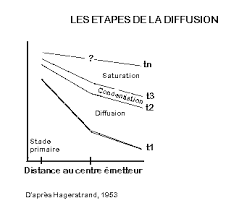Unit 6 Urban Rural Transfer Mechanism
Spatial Diffusion of Innovation Model by T. Hagerstand
- Spatial diffusion refers to the process by which new innovation spread over the geographical space through settlement locations.
- Diffusion phenomena may include migration of population, settlement growth, cultural traits, technological innovations, human and animal diseases etc.
- The spatial diffusion of innovation model of T. Hagerstrand has been emanated during early 1950s is outstanding which aids understanding of individual behavior in the spatial context. His model holds that diffusion of innovations take place in a social system that is localized in geographical space.
- People works as innovator, receiver and carrier of new innovation for diffusion.
- The model describes that the innovations move efficiently from higher order fashion and therefore it is relevant to explain the process of diffusion of various economic and social phenomena between different levels of urban settlements.
Assumptions
- Isotropic landscape
- Equal distribution of population
- Equal distribution of transportation facility
Analysis of the theory
1. Four stages of diffusion of innovation of waves

- Stage I (Primary Stage): This stage marks as the beginning of the diffusion process, in which there is a strong contrast between the innovative centers and remote areas.
- Stage II (Diffusion Stage): This stage indicates the diffusion process in proper way. During this stage, there is a strong centrifugal effect with the creation of new, rapidly growing centers in the distant areas and a reduction in the regional contrasts of the primary stage.
- Stage III (Condensing Stage): This stage refers to the condensing stage in which the relative increase of diffusion is increased in equal manner in all three locations.
- Stage IV (Saturation Stage): In thisstage, the stage of innovation reaches to the maximum level but it has slow rate of diffusion to reach the saturation stage. Certain percentage of people (about 16%) may not adopt the innovation which is said as 'laggard'.
2. The factors influencing the process/ Controlling factors of the model
a. Distance
b. Time (Stage)
c. People (Neighbor)
a. Distance (Distance Decay Function)
- It plays a significant role in the process of diffusion or innovation.
- First of all diffusion takes place to the nearest settlement/ neighboring area, then it only moves towards further areas.
- There is inverse relationship between distance and interaction/ innovation. This idea is known as 'distance decay'. It says that higher the distance, lower the diffusion of innovation and lower the distance, higher the diffusion of innovation.
- why distance decay takes place?
longer distance takes higher cost of transportation.
It is time consuming as well.
Make a figure....
Sharp fall for low distance, slow decline for higher distance.
AB: Sharp fall
BC, CD, DE, EF: Slow decline
b. Time
Innovation does not takes place over all area at once. It takes time to spread its impact in all places of an area. For eg: Use of cell phone in Kathmandu. The four stages of diffusion of innovation is related as a time factor.
c. People (neighbors)
It is also said as "Neighborhood Effect". Here exist, face to face relation and social contact.
Conditions
- During the starting stage, only the carrier knows or brings an information of innovation.
- The probability of acceptance depends on the receivers and time. (receivers in a sense that how capable is he/she to receive).
- The information of innovation transfer orally by face to face contact or inter-personnel communication.
- Every carrier/knower at each time passes the ideas to another non-knower.
- Face to face contact is influenced by distance.
A__ B_C_D................(Diffusion of Innovation)
In the beginning stage, few people accept the innovation/new idea. On the second stage, number of acceptance increases. In the third stage, it goes rapidly. Finally, in the fourth stage, the growth becomes slow. 100% people cannot accept an innovation. About 16% people do not accept it.
Application of Monte Carlo Model
The model is quite sophisticated and ambitious whereas Hager Stand has applied Monte Carlo Model as follows:
- A potential adapter/ accepter is assumed to accept an innovation as soon as he is told by another accepter/person.
- Every receiver is allowed to contact and pass on information to another person, adopter and non-adopter.
- The reduction in interpersonal communication is caused by physical features like rivers, mountains, forests etc.
Criticism
- The theory is quite sophisticated rather than practical.
- So, it requires a well documentation of data relating to spread an innovation.
- It depends upon various economic and cultural characteristics of population. It should be properly mentioned.